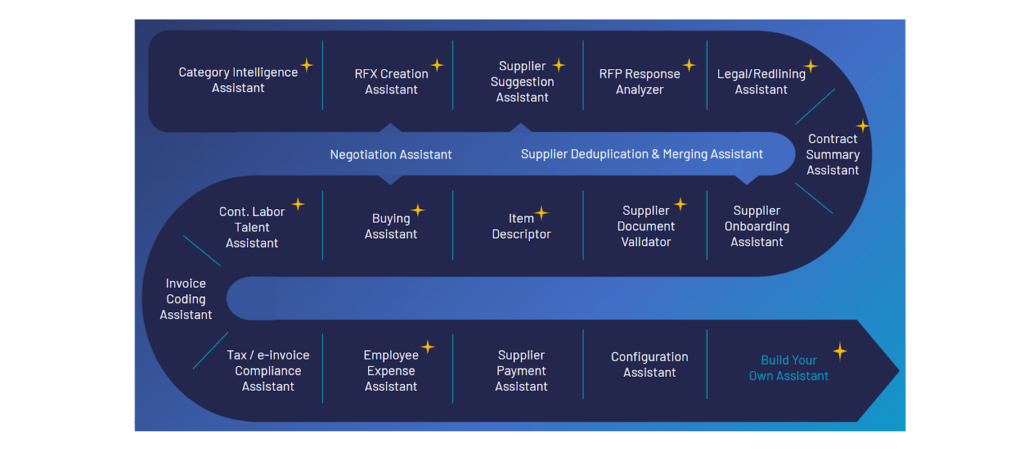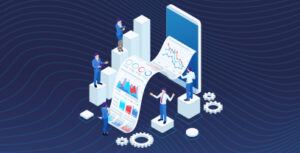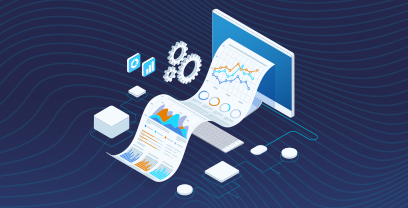E-procurement is a digital process spanning the entire procurement lifecycle, from sourcing and contracting to ordering, invoicing, and payment.
Unlike basic online purchasing tools, a sophisticated e-procurement system provides an integrated solution that connects all procurement functions. This connectivity helps to eliminate spreadsheets, email threads, and manual approval bottlenecks that can slow down processes and drive up costs.
If you’re beginning to explore e-procurement, you’ve probably been grappling with manual approvals that delay purchases and limited visibility into spend. Or maybe you have an outdated ERP system that requires complex workarounds. Fortunately, e-Procurement addresses these common problems.
This guide paints a clear picture of what e-procurement really is: not just digital purchasing, but a modern system that brings structure, visibility, and control to the entire procurement process. We will walk you through the full e-procurement lifecycle, so you can see how each step works together, and explain how leading procurement teams are leveraging AI and automation to improve efficiency and accuracy.
Key Takeaways
- Manual processes and outdated ERPs create inefficiencies like rogue spend, slow approvals, and compliance risks.
- E-procurement goes beyond digital purchasing processes, connecting sourcing, contracting, ordering, and invoicing in a single system.
- Modern e-procurement platforms use automation and AI to streamline workflows, enforce policies, and improve spend visibility.
| See how e-procurement transforms sourcing to payment. Watch Demo / Find Out More |
The E-Procurement Process: From Request to Payment
Modern e-procurement doesn’t simply digitize purchasing processes. It provides a structured, end-to-end digital framework that provides better control and consistency throughout the Procure-to-Pay (P2P) lifecycle.
A unified e-procurement system covers every stage of the P2P lifecycle, eliminating manual handoffs and disconnected tools, so that approvals are faster and more efficient.
The following seven stages form the backbone of a scalable, policy-aligned e-procurement system:
1) E-informing
The e-procurement journey begins with internal alignment. E-informing ensures that employees across departments can easily access procurement policies, approved vendor lists, and negotiated contract terms in one centralized location.
By giving stakeholders a high degree of transparency and access to the information they need when they need it, you can eliminate confusion about how to buy, reduce maverick spend, and drive compliance from the start. As a result, scattered PDFs become a thing of the past – as do random emails asking for information about the source of a purchase.
2) E-sourcing
Once demand is clear, e-sourcing enables teams to launch sourcing events through structured, automated workflows. E-sourcing streamlines supplier discovery, qualification, and evaluation using embedded compliance criteria and scoring logic.
E-sourcing accelerates supplier selection while ensuring that decisions are transparent and defensible. For more detail on optimizing sourcing, see our guide to e-sourcing strategy.
3) E-tendering
E-tendering takes traditional RFx processes such as RFPs, RFQs, and RFIs, and brings them into a collaborative digital workspace. Teams can issue requests, compare vendor responses side-by-side, and evaluate proposals against pre-defined criteria.
With e-tendering, all communication and documentation are captured in one place, which removes the need for email chains and offline scoring spreadsheets. All feedback is unified for better insights into RFx processes.
4) E-auctioning
For highly competitive or commodity-based categories, e-auctions enable real-time, transparent price negotiations between suppliers. Procurement teams use e-auctioning software to run reverse auctions or dynamic bidding events, where multiple suppliers compete to offer the best price for a standardized product or service.
E-auctioning drives cost savings while ensuring fairness and transparency. Instead of relying on lengthy phone calls and manual spreadsheet comparisons, purchasing decisions happen in minutes, with automated tracking and audit trails included.
5) E-ordering
Once you select a supplier, you can automatically convert requisitions into purchase orders using policy-based approval flows in the e-procurement system. E-ordering ensures that the right stakeholders are looped in at the right time, without having to manually route approvals or chase down signatures.
Built-in controls prevent over-ordering, and you can route POs based on value thresholds to keep teams aligned with budget control expectations.
6) E-invoicing
With e-invoicing, suppliers submit invoices directly through the e-procurement platform, which performs automated 3-way matching and generates the corresponding PO and receipt. This automation reduces invoice processing times significantly while improving accuracy.
Additionally, you can set validation rules to flag discrepancies before they cause downstream payment delays. Exception handling can be standardized across the organization, as well.
7) E-contract management
E-contract management enables you to store contract terms, SLAs, and expiration dates digitally, and monitor them within the system. You can set automated alerts to notify teams of upcoming renewals, compliance risks, or deviations from negotiated pricing, as well.
Alerts help to ensure that spend stays on contract and reduce the risk of surprise renewals or noncompliant purchases. E-contract management also ensures no documentation is missing when it’s time for an audit.
One System, Full Visibility and Control
By linking these seven stages in a single system, you gain full visibility and control across the Procure-to-Pay process. What’s more, category managers no longer have to rely on spreadsheets, outdated ERP reports, or scattered email threads for supplier performance or contract compliance tracking.
With a comprehensive e-procurement system, you’re empowered to operate efficiently and reduce risk, while driving greater value from every dollar your organization spends.
Now that we’ve covered the seven core features of a modern e-procurement system, let’s take a closer look at why you need one to replace your legacy ERP system.
Why ERP Systems Fall Short for Modern Procurement
Many procurement teams still rely on legacy ERP systems that were never designed for handling the procurement process from start to finish. These platforms typically lack end-to-end purchasing workflows or embedded functionality for automated approvals.
Because they were built with older technology, legacy ERP systems cannot support real-time supplier collaboration or contract enforcement.
As a result, your teams rely on inefficient workarounds, such as routing purchase orders through email or manually matching invoices. They may even still be tracking commitments in separate spreadsheets.
These gaps create real business risks, such as duplicate or unauthorized spend, missed savings from non-compliant purchases, or increased exposure during audits. Without a purpose-built procurement layer, it’s nearly impossible to enforce policies or manage supplier performance, let alone maintain visibility into your spending.
How E-procurement Integrates with ERP
E-procurement platforms act as a dedicated layer on top of your ERP, delivering the procurement-specific functionality that traditional systems lack. These platforms manage sourcing, approvals, and purchasing workflows, while seamlessly syncing financial and supplier data back to the ERP, preserving it as the system of record for accounting.
This approach offers numerous benefits:
- It enables better visibility and collaboration across teams.
- Finance gains real-time insight into procurement activity and supply chain management.
- Procurement teams benefit from intuitive tools designed for their processes.
What’s more, shared, synchronized data eliminates duplicate entries and reduces delays. For example, a Head of AP can reconcile invoices in days instead of weeks, thanks to automated matching and validations.
With Ivalua’s Procure-to-Pay (P2P) platform, organizations can integrate tightly with existing ERPs to enhance visibility, control, and efficiency across the entire purchasing cycle, without overhauling core financial systems.
How AI Prevents Procurement Mistakes Before They Happen
Artificial Intelligence (AI) is already transforming procurement by reducing human error and increasing efficiency. How? Today’s AI tools can:
- Automatically route approvals based on spend category, amount, and role, ensuring the right eyes are always on a purchase.
- Flag non-compliant purchases before they’re submitted
- Analyze supplier performance trends over time
- Identify hidden risks in contracts that might otherwise go unnoticed.
But AI is only effective if it has access to clean, structured data. That’s why digitized workflows and integrated systems are essential.
Ivalua, for example, uses AI agents in procurement to proactively highlight policy violations, suggest preferred suppliers, and surface savings opportunities in real time. This helps procurement teams prevent costly mistakes before they’re made.
But before you can modernize procurement or automate key tasks with AI, you need a clear picture of how things work today. Mapping your current requisition-to-order workflow reveals where delays, confusion, and inefficiencies are hiding, so you can target improvements that deliver immediate impact. The image below highlights the expanding role of agentic AI across various procurement applications.

How To Start: Map Your Requisition-To-Order Workflow
As you begin to map the requisition process, ask yourself some key questions to uncover inefficiencies and identify areas in need of improvement:
- How are purchase requisitions submitted?
- Who reviews and approves them?
- Where do bottlenecks or errors typically occur?
Common pain points include email-based approvals that get lost or ignored, unclear approval hierarchies that delay progress, and manual budget checks that lead to duplicate or misaligned purchase orders. These gaps are signs that your team is ready for procurement automation.
By introducing structured workflows and digital controls, an e-procurement system can create immediate value. Learn more about streamlining this process in our guide to the purchase order automation process.
E-Procurement Is the Foundation for Smarter, Safer Spend
The complex challenges of modern procurement can’t be solved with outdated tools. E-procurement platforms provide the structure, visibility, and intelligence needed to run a more agile and data-driven procurement function.
By digitizing your procurement processes, you can eliminate inefficiencies and prepare your organization to take full advantage of advancements in procurement technology.
Ivalua delivers a complete e-procurement software solution that connects sourcing, contracting, and purchasing in one unified platform, giving procurement and finance teams the visibility, control, and strategic advantage they need.
| Explore how modern e-procurement solves real-world process inefficiencies. Watch Demo / Find Out More |
FAQs
What are the main components of an e-procurement system?
E-procurement systems typically include modules for strategic sourcing, ordering, contract management, and invoicing. These modules are connected through rules-based workflows that enforce compliance and provide real-time visibility across teams.
What are the different types of e-procurement?
E-procurement includes e-sourcing (digital supplier selection), e-tendering (electronic proposal evaluation), e-auctioning (real-time bidding), e-ordering (automated purchase orders), e-invoicing (digital invoice processing), and e-contract management (digital contract tracking). These modules work together to create end-to-end digital procurement workflows.
What is an e-procurement tool?
An e-procurement tool is procurement software that digitizes and automates procurement functions, from catalog management to approval workflows. Modern tools include supplier management portals (vendor portals), spend analysis software, ERP integration, and AI capabilities to eliminate manual processes while maintaining control over organizational spending.
How does e-procurement help with compliance?
By embedding policies into workflows, e-procurement systems ensure that purchases are approved based on defined roles and budgets. Every transaction is logged, creating an auditable trail that supports both internal controls and external regulations.
Can e-procurement work with existing ERPs?
Yes. Modern e-procurement platforms like Ivalua are designed to integrate with ERP systems, using APIs or connectors to sync financial data. This allows procurement teams to enhance ERP functionality without duplicating processes.
What types of companies need e-procurement?
Any organization with distributed spend, complex sourcing, or regulatory oversight benefits from e-procurement. This includes enterprises with global teams, decentralized business units, or high-value supplier relationships.
Is e-procurement expensive to implement?
Implementation costs vary by organization size and complexity, but many platforms offer phased rollouts. The value typically comes from reduced maverick spend, faster cycle times, and better compliance.




